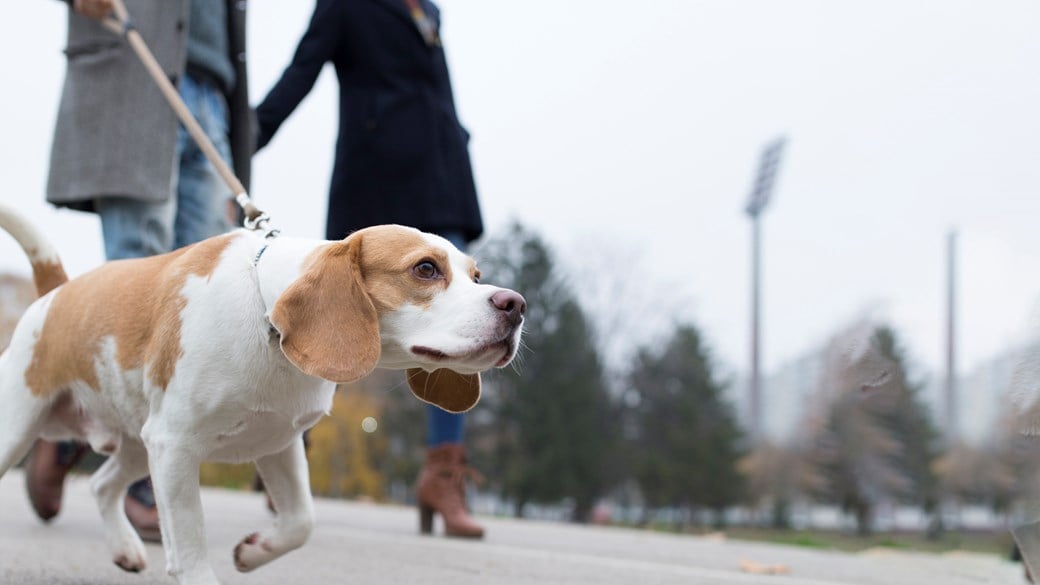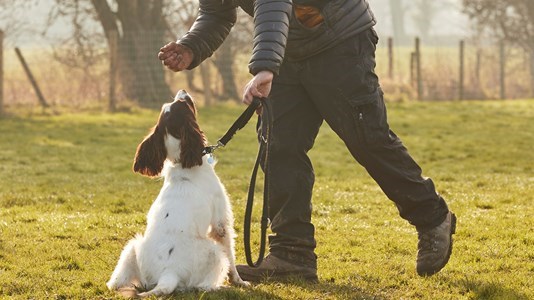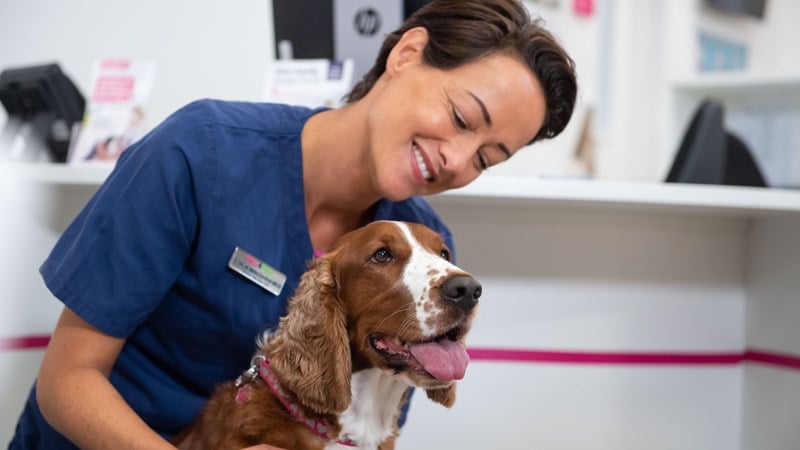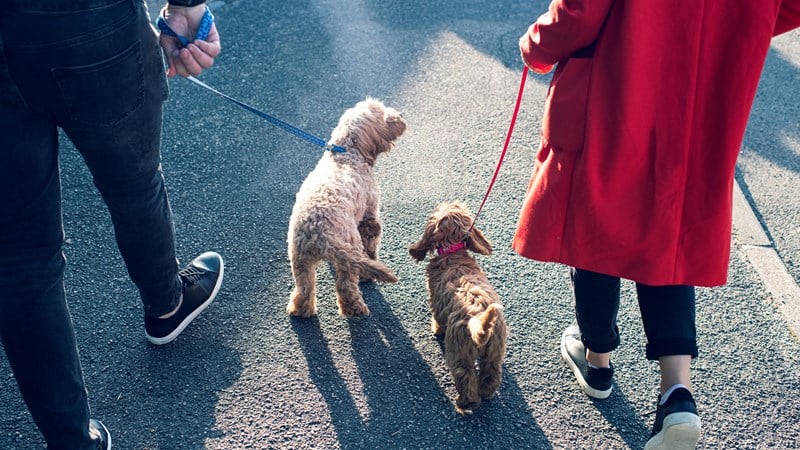
Adolescent Dog Training Tips
It can be a challenging time as your puppy becomes an adolescent, so take a look at our top tips
You’ve got through the puppy training and early socialisation weeks and your puppy knows how to sit, lie down and wait when you ask them to. They even have a recall to be proud of. Why then, has all this suddenly been forgotten and your bright, cooperative little puppy has apparently turned into a rebel who won’t come back when you call? The answer is that they’ve become an adolescent!
Puppies generally reach adolescence at around six months and the phase lasts until they’re around 18–12 months. It’s very much like when children become teenagers!
Take a look at our top dog training guides here.
What might I expect from my adolescent dog?
Just like teenagers, adolescence can sometimes bring with it a few hiccups. While some dogs sail through it, others can become a little wayward – they might seem to have more important things to do when you’re trying to get them to come back to you, or they may suddenly become more reactive with other dogs. Sometimes, dogs go through a fearful phase during adolescence. The good news is that, if your once easy-to-live-with puppy does become a little challenging, it won’t last forever.
The most important thing you can do to help them through this time is to continue with patient, understanding, and consistent training. Let’s take a look at how to approach some of the challenges you might face with your adolescent dog…
As your young dog leaves behind puppyhood, naturally, they’ll tend to become more adventurous and want to explore more of their world to find out who else is around. It’s quite normal for male dogs in particular to become preoccupied with following the scents of other dogs. Many young dogs suddenly discover that there’s a whole lot of exciting stuff out there and temporarily, this overrides the training they’ve learned.
If your young dog is taking longer to respond to basic commands, or ignoring you altogether, you’ll need to go back a few steps and revise some of your training, making it really easy for them to succeed and rewarding them well when they respond more quickly. They’ll be making a choice between doing what their instincts tell them and what you’re asking them to do. Following their own agenda is often innately rewarding, so it’s important to tip the balance in your favour by using rewards your dog really values.
To help your dog with their recall, it helps to remember that this isn’t about your dog being naughty or rebellious so, first and foremost, never tell them off when you eventually do manage to get them to come to you. That would only make them less likely to want to come to you the next time. Instead, consider attaching a long line to their harness (never to their collar, in case they should catch it on anything).
Hold the end of the line while allowing your dog some freedom and use it to reel them in when you call them. You don’t want them to get into the habit of needing to be asked several times to come to you, as that’s difficult to stop doing. Instead, give one command, gather in the line and reward your dog well, before allowing them freedom again. This way, they know that the fun doesn’t always stop when they’re called in. Using variable rewards your dog values helps them to choose you over an interesting smell on the ground!
Pick your places carefully for allowing your dog freedom. It’s more difficult for them to choose you if there are lots of other dogs running around, or other distractions. Until things get a bit easier with commands, manage your expectations and only ask your dog difficult things like recalls when there are fewer alternative choices available to them. Until you think your dog’s recall is reliable again, keep them on a lead for their own safety, and to prevent them from rushing over to other dogs who may find the attention unwelcome.
You’ve probably worked hard on socialising your puppy, so it can come as a bit of a surprise if they suddenly start alarm-barking at situations or things around which you thought they were comfortable. This is another normal phenomenon and, with support from you, it soon passes.
Not all dogs will show fearfulness during their adolescence, but if they do, remember how you carried out their socialisation in the beginning and try to fit in low-key experiences like you did when they were young. Aim to keep the experiences of a low enough intensity that they don’t produce a fearful response in your puppy, by physically distancing yourselves from the situation or object of interest and by breaking your puppy’s constant focus on the situation with a game and some rewards.
If you can identify which situations seem to be worrying your puppy the most, you can focus on these but, again, aim to keep them to a very low intensity at first and only build up when you see your puppy is comfortable with them at the level you’ve tried.
If you’ve noticed that your young dog seems to be more anxious than usual, avoid any situations out of their normal routine that may frighten them and be difficult to overcome. Experiences where they’re separated from you, like staying in a boarding kennels, or going to the vet’s for anything that could have waited, are better postponed until your dog is feeling more confident.
You can always discuss with your vet team how urgent a scheduled visit is before deciding. If there are family events while your dog is going through a worried phase, avoid situations where your home is filled with people and, if visitors are unavoidable, explain that your dog is feeling a little anxious. Ask them not to seek out interactions, but to allow your dog to choose whether to approach them for gentle, calm attention. Give your dog a safe space that’s familiar to them and that will allow them to withdraw away from visitors when they need quiet time.
Just like with teenagers, social interactions are really important to adolescent dogs. So, it won’t come as a surprise to know that they can get a little distracted when they spot other dogs and they may be more boisterous or persistent in their dog-dog interactions. While we all want our dogs to be friendly and to be able to have dog friends and play nicely with them, it can sometimes get a bit intense! Some dogs you’ll meet out and about will not feel comfortable being approached by an excited youngster, and they (and their owners) may react quite strongly if your puppy pesters them.
If you know other dogs with whom your puppy can play, supervise their interactions and if you see things getting out of hand, for instance, one dog chasing another and only the one who’s doing the chasing appearing to be happy about it; or rough play, such as one dog shoulder-slamming or pushing another around, interrupt them and offer your puppy a game with you instead.
Ideally, you need your puppy to feel that you’re the centre of their world. This means you need to be able to play the best games with them so that, while they’re happy to make friends with other dogs and to have a play when appropriate, they will choose to go with you when you ask them to.
Sometimes, people hope that neutering their young dog might help to ‘calm them down’. Unwanted behaviour that is sexually motivated can be reduced, if neutering is supported by training, but it’s not a magic way to a calm dog or to ensure that they have trouble-free social interactions. Neutering has body-wide effects, and the best person with whom to discuss whether and when it’s appropriate for your dog, is your own vet.
Some dogs have already built themselves a reputation for chewing and destructiveness by the time they get to adolescence, but even the ones who haven’t been great chewers throughout puppyhood sometimes discover this pastime during adolescence. It may be that chewing helps with any discomfort associated with the adult teeth erupting and settling in.
Chewing strengthens the ligaments that hold the teeth within their bony sockets. It’s beneficial in other ways, too: it has a calming, relaxing effect. Appropriately directed chewing is great for dogs who are young and busy, and who might feel a little frustrated at times!
This may be another passing phase but, in any case, it’s important to provide safe items for all dogs to satisfy their need to chew. You may need to experiment if you haven’t already found out what sort of chews your dog prefers. Dogs who have a strong and determined bite can sometimes break chunks off their chews and swallow them, or they can fracture their teeth on very hard chews. At the other end of the scale, giving very tough chews to dogs who don’t have a strong bite can dishearten them if they don’t feel as though they’re making progress.
Keeping adolescent dogs entertained
Puppies and young dogs have a lot of energy. As tempting as it is to go to the park and throw a toy repeatedly until they’re so tired they can only shuffle home for a lie down, this isn’t great at all for their developing bodies and it can, in fact, harm them. It’s far better to stick to sensible exercise levels (If you’re not sure what’s appropriate, check out our exercise article here or ask your vet team) and to look for ways to exercise their brains instead.
Scent work is a great way to give a dog a mental workout and it’s emotionally satisfying for them, too. You can teach your dog very easily to use their nose to find toys or other items that you’ve hidden around the home or garden. Training your dog is another way to help dogs to relax and settle.
You could practice basic training, or you could look into trick training – this can be really good fun for both of you and has the added benefit of strengthening your relationship. Just five minutes of training, two or three times a day, can help to settle a busy young dog down.
If you’re using food rewards for training, keep an eye on your dog’s body condition to make sure they aren’t gaining too much weight. Body condition is easy to monitor – take a look at our guide to body condition scoring here. By feeding your dog their meals from an interactive or puzzle feeder, you can make mealtimes last longer and, by making them work for their food, keep them entertained and busy.
If you can approach your dog’s adolescence with understanding and kind, consistent, reward-based training (or retraining!), you’ll all come out of the other end of this life stage with strong foundations for a happy adulthood!
Getting started with training

Health Plans to keep your puppy healthy
At Vets4Pets we offer a range of Health Plans that make essential routine treatments more affordable. You'll save money on things like annual vaccinations, flea and worm treatment and routine health check-ups.

Join our free VIP Puppy club
Join the club for expert advice and tailored offers, including £30 off our Complete Care Health Plans

Puppy & Kitten Advice
Giving your pet the best start in life begins with getting the best expert advice.
